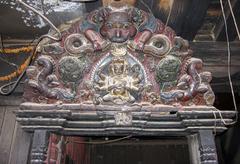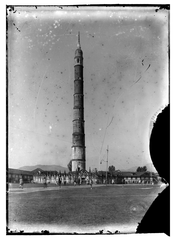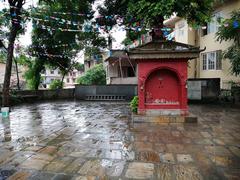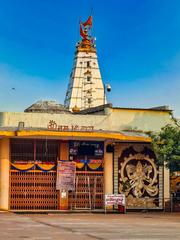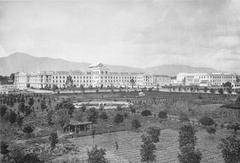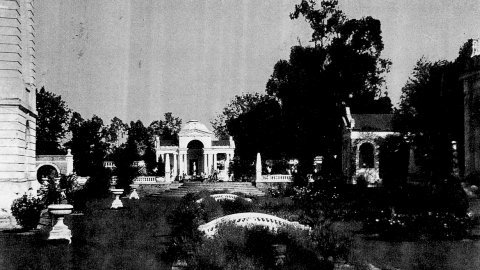
Visiting Garden of Dreams: Hours, Tickets, and Guide
Date: 17/07/2024
Introduction
Nestled in the vibrant heart of Kathmandu, Nepal, the Garden of Dreams is a historical oasis known for its serene ambiance and rich cultural heritage. Often referred to as the Garden of Six Seasons, this neo-classical garden offers a unique blend of European and Nepalese architectural styles. Built in the early 1920s by Field Marshal Kaiser Shumsher Rana and designed by Kishore Narshingh, the garden originally spanned over 74,000 square feet and was inspired by the Edwardian gardens of Europe (Garden of Dreams Official Website, Lonely Planet).
The Garden of Dreams serves as a testament to Nepal’s ability to harmonize diverse cultural elements. It features six pavilions representing the six seasons of Nepal, along with fountains, pergolas, and meticulously maintained flora. This blend of Eastern and Western architectural elements makes the garden a unique landmark in Kathmandu. Additionally, the garden has played a significant role in the social and cultural life of the city, transforming from a private garden for the elite to a public space that hosts numerous cultural events and gatherings (Kathmandu Post).
This guide aims to provide a comprehensive overview of the Garden of Dreams, covering its historical significance, architectural wonders, visitor information, and tips for making the most of your visit. Whether you’re a history enthusiast, a nature lover, or simply looking for a peaceful retreat in the bustling city, the Garden of Dreams offers something for everyone.
Table of Contents
- Introduction
- History and Significance
- Visitor Information
- Restoration and Conservation Efforts
- Symbolism and Design Elements
- Modern-Day Relevance
- Visitor Experience
- Educational and Research Opportunities
- Future Prospects
- Nearby Attractions and Travel Tips
- FAQ
- Conclusion
History and Significance
Historical Background
The Garden of Dreams, a neo-classical garden, was built in the early 1920s by Field Marshal Kaiser Shumsher Rana, a prominent figure in Nepalese history. Designed by Kishore Narshingh, the garden was inspired by the Edwardian style of gardens prevalent in Europe. Originally spanning over 74,000 square feet, it included pavilions, fountains, decorative garden furniture, and European-inspired verandas (Garden of Dreams Official Website).
Architectural Significance
The Garden of Dreams is a prime example of the fusion of European and Nepalese architectural styles. The garden’s layout is symmetrical, with a central axis leading to various pavilions and water features. The six pavilions represent the six seasons of Nepal, a unique feature that highlights the country’s cultural heritage. The garden also includes pergolas, balustrades, urns, and birdhouses, all intricately designed to add to the garden’s aesthetic appeal (Lonely Planet).
Cultural and Social Importance
The Garden of Dreams has played a significant role in the social and cultural life of Kathmandu. During the Rana regime, it served as a private garden for the elite, hosting numerous social gatherings and events. After the fall of the Rana regime, the garden fell into disrepair but was later restored with the help of the Austrian government and the Nepalese Ministry of Education. Today, it serves as a public space where locals and tourists alike can enjoy a peaceful retreat from the bustling city life (Kathmandu Post).
Visitor Information
Visiting Hours and Tickets
The Garden of Dreams is open daily from 9 AM to 10 PM. Tickets can be purchased at the entrance, with prices varying for locals and tourists. For the latest ticket prices and discounts, visitors should check the Garden of Dreams Official Website.
Accessibility
The garden is wheelchair accessible, with pathways and amenities designed to accommodate all visitors. Guided tours are available and can be booked in advance through the official website.
Restoration and Conservation Efforts
The restoration of the Garden of Dreams began in 2000 and was completed in 2007. The project aimed to preserve the garden’s historical and architectural integrity while making it accessible to the public. The restoration was carried out by the Eco Himal Society, an Austrian NGO, in collaboration with the Nepalese government. The project cost approximately $2.5 million and included the restoration of the pavilions, fountains, and other architectural elements. The garden now features a museum, a library, and a café, making it a multi-functional space that caters to various interests (Eco Himal).
Symbolism and Design Elements
The Garden of Dreams is rich in symbolism, with each element carefully designed to reflect Nepalese culture and heritage. The six pavilions, for instance, symbolize the six seasons of Nepal: Basanta (spring), Grishma (summer), Barsha (monsoon), Sharad (autumn), Hemanta (pre-winter), and Shishir (winter). The garden’s layout is also designed to create a sense of harmony and balance, with water features and pathways leading visitors through different sections of the garden. The use of European design elements, such as pergolas and balustrades, adds a unique touch to the garden, making it a blend of Eastern and Western architectural styles (Nepal Tourism Board).
Modern-Day Relevance
Today, the Garden of Dreams is one of Kathmandu’s most popular tourist attractions. It offers a serene environment where visitors can relax and enjoy the beauty of nature. The garden also hosts various cultural events, including art exhibitions, musical performances, and literary festivals, making it a hub for cultural activities in the city. The garden’s café and restaurant provide a perfect setting for social gatherings, while the museum and library offer educational opportunities for visitors interested in learning more about Nepalese history and culture (TripAdvisor).
Visitor Experience
Visitors to the Garden of Dreams can explore its various sections, each offering a unique experience. The central pavilion, known as the Kaiser Mahal, is a highlight of the garden and features intricate woodwork and decorative elements. The garden’s water features, including fountains and ponds, add to the tranquil atmosphere, while the lush greenery and colorful flowers provide a visual feast for the eyes. The garden also offers guided tours, allowing visitors to learn more about its history and significance (Garden of Dreams Official Website).
Educational and Research Opportunities
The Garden of Dreams is not just a place for leisure; it also serves as an educational and research center. The garden’s library houses a collection of books and manuscripts related to Nepalese history, culture, and botany. Researchers and students can use the garden as a case study for various academic disciplines, including architecture, landscape design, and cultural studies. The garden also collaborates with local and international institutions to promote research and knowledge exchange (Eco Himal).
Future Prospects
The Garden of Dreams continues to evolve, with plans for further development and conservation. The management aims to enhance the visitor experience by introducing new features and amenities while preserving the garden’s historical and cultural significance. Future projects include the restoration of additional sections of the garden, the introduction of interactive exhibits, and the organization of more cultural events. These efforts aim to ensure that the Garden of Dreams remains a cherished landmark in Kathmandu for generations to come (Kathmandu Post).
Nearby Attractions and Travel Tips
Visitors to the Garden of Dreams can also explore nearby attractions such as the Narayanhiti Palace Museum, Thamel, and the Kathmandu Durbar Square. It is advisable to visit early in the morning or late in the afternoon to avoid the crowds and enjoy a more peaceful experience. Additionally, wearing comfortable shoes and bringing a camera can enhance your visit.
FAQ
Q: What are the Garden of Dreams visiting hours? A: The garden is open daily from 9 AM to 10 PM.
Q: How much are the tickets for the Garden of Dreams? A: Ticket prices vary for locals and tourists. For the latest prices, check the Garden of Dreams Official Website.
Q: Is the Garden of Dreams wheelchair accessible? A: Yes, the garden is wheelchair accessible, with pathways and amenities designed to accommodate all visitors.
Conclusion
The Garden of Dreams stands as a remarkable testament to Nepal’s rich cultural heritage and architectural prowess. Its unique blend of European and Nepalese design elements, combined with its serene environment, makes it a must-visit destination in Kathmandu. Over the years, the garden has evolved from a private sanctuary for the elite to a public space that welcomes both locals and tourists. The restoration and conservation efforts have preserved its historical and architectural integrity, ensuring that it remains a cherished landmark for future generations (Eco Himal).
Today, the Garden of Dreams is more than just a historical site; it is a vibrant hub for cultural activities, educational opportunities, and social gatherings. From its lush greenery and intricate pavilions to its tranquil water features and vibrant flora, the garden offers a memorable experience for all visitors. Whether you’re exploring its historical significance, enjoying a peaceful stroll, or participating in one of its many cultural events, the Garden of Dreams provides a unique and enriching experience. Plan your visit today and immerse yourself in the beauty and history of this extraordinary garden (TripAdvisor).
References
- Garden of Dreams Official Website https://www.gardenofdreams.org.np
- Lonely Planet https://www.lonelyplanet.com/nepal/kathmandu/attractions/garden-of-dreams/a/poi-sig/1142764/357551
- Kathmandu Post https://kathmandupost.com/art-culture/2020/02/14/the-garden-of-dreams-a-historical-oasis-in-the-heart-of-kathmandu
- Eco Himal https://www.ecohimal.org/en/projects/garden-of-dreams
- TripAdvisor https://www.tripadvisor.com/Attraction_Review-g293890-d447456-Reviews-Garden_of_Dreams-Kathmandu_Kathmandu_Valley_Bagmati_Zone_Central_Region.html

